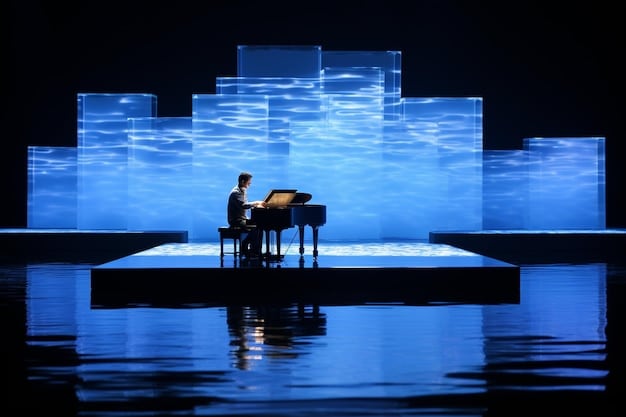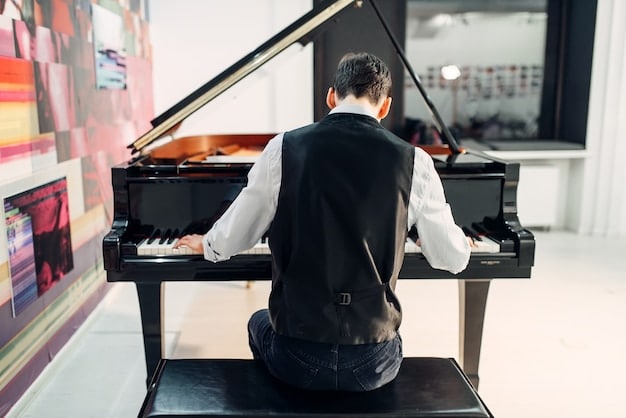The Art of the Soundtrack: Elevating Series with Memorable Music

The art of the soundtrack is crucial in series production, profoundly influencing audience engagement and narrative depth by weaving emotional and thematic layers through meticulously crafted musical compositions.
In the vast landscape of television and streaming, where narratives unfold across hours and seasons, the unsung hero often lurking in the background, yet propelling every emotion and amplifying every climax, is the soundtrack. When we discuss The Art of the Soundtrack: Celebrating the Music That Makes a Series Memorable, we delve into a profound symbiotic relationship where music transcends mere accompaniment to become an integral character, shaping perception and engraving scenes into our collective memory. This is not just about background noise; it is about intentional composition, curated selections, and the masterful integration of sound that transforms a good series into an unforgettable cultural phenomenon.
Beyond Background: The Soundtrack as Narrative Architect
The role of a soundtrack extends far beyond simply filling silence between dialogues or action sequences. It acts as an invisible narrative architect, subtly guiding the audience’s emotional journey and deepening their understanding of the story. From setting the initial mood of a scene to foreshadowing events and developing character arcs, music is a powerful, non-verbal communicator integral to the storytelling process.
Consider the opening credits; often, the theme song becomes a signature, instantly recognizable and evocative of the series’ core identity. This meticulous crafting of sonic landscapes helps to immerse viewers, creating a stronger connection between the audience and the fictional world being presented. It’s about building a universe not just with visuals and dialogue, but with an auditory foundation that resonates deeply.
Setting the Scene: Mood and Atmosphere
One of the primary functions of a soundtrack is to establish the mood and atmosphere. A somber cello melody can immediately convey tragedy, while a vibrant, rhythmic piece can instantly signal excitement or intrigue. This initial auditory impression is critical in preparing the audience for the narrative to come, allowing them to adjust their emotional state accordingly.
- Emotional Resonance: Music elicits strong emotional responses, whether it’s joy, fear, sadness, or triumph, making scenes more impactful.
- Genre Signature: Specific musical styles can instantly telegraph the genre, from the suspenseful strings of a thriller to the whimsical melodies of a comedy.
- Pacing and Rhythm: The tempo and rhythm of the music dictate the pace of the scene, accelerating tension or drawing out moments of contemplation.
The strategic deployment of different musical elements, from leitmotifs associated with particular characters to broader orchestral themes for significant locations, builds a comprehensive sonic tapestry. This tapestry is unique to each series, making its auditory signature as distinct as its visual style.
Ultimately, the soundtrack’s ability to seamlessly blend into the visual narrative while simultaneously enhancing it is what elevates a production. It’s a testament to the composer’s skill and the creative team’s vision when music becomes an almost subconscious guide for the audience, leading them through the story’s emotional labyrinth with precision and grace.
Character & World-Building Through Sound
Music is not merely a backdrop; it is an active participant in developing characters and fleshing out the fictional worlds they inhabit. Just as costume design or dialogue can tell us about a character, so too can their associated musical themes. These musical motifs often evolve with the characters, reflecting their growth, their struggles, and their eventual transformations.
Think about a particular character’s theme: a recurring melody that plays whenever they are central to the scene. This theme can be subtle or overt, but its consistent presence creates an auditory shorthand for their personality and motivations. A whimsical melody might accompany a quirky, unpredictable character, while a melancholic, string-heavy piece could define a more brooding or tragic figure. These musical identifiers help to deepen our understanding and connection to the characters without a word being spoken.
Beyond individual characters, soundtracks also play a pivotal role in world-building. Distinct musical palettes can define different locations or cultures within a series. A sprawling fantasy epic might use epic orchestral scores for grand landscapes and folk-inspired melodies for quaint villages, immediately differentiating environments and enhancing the sense of immersion. This detailed sonic architecture contributes significantly to the verisimilitude of the fictional world, making it feel more real and believable to the audience.
- Iconic Character Themes: Memorable themes instantly recall characters and their journeys, even years after a series concludes.
- Cultural Identity: Music can reflect the cultural or historical setting of a series, adding authenticity and depth.
- Emotional Arcs: The evolution of a character’s theme over seasons mirrors their personal growth and significant life changes.
The careful consideration given to how music expresses aspects of a character’s inner world or defines the unique feel of a fictional setting underscores the profound impact of a well-crafted soundtrack. It’s a layer of storytelling that speaks directly to the subconscious, shaping our perceptions and investing us more deeply in the narrative.

Moreover, the integration of diegetic music – music that exists within the world of the story, heard by the characters themselves – can further enhance world-building. A radio playing a specific song, a band performing in a tavern, or a character singing a lullaby can provide invaluable context, hinting at the prevalent culture, time period, or emotional state of the characters, adding another layer to the narrative richness.
The Power of a Leitmotif: Emotional Anchors
The leitmotif, a recurring musical theme associated with a particular person, idea, or situation, is one of the most potent tools in a composer’s arsenal. It functions as an emotional anchor, instantly calling to mind specific elements of the story and guiding the audience’s perception without explicit dialogue or visual cues. When a leitmotif resurfaces, even briefly, it carries with it all the accumulated emotional weight and narrative context from its previous appearances.
This technique allows composers to create intricate layers of meaning, hinting at character intentions, foreshadowing plot developments, or recalling past moments of significance. A subtle variation in a leitmotif can indicate a character’s internal conflict or a shift in their trajectory. Its sudden absence can signify loss, while its triumphant return can herald victory. This sophisticated use of recurring musical phrases elevates the emotional stakes and enriches the viewer’s experience.
Deepening Emotional Connections
Leitmotifs are highly effective in deepening the emotional connection between the audience and the narrative. By associating distinct melodies with key elements, composers establish a powerful auditory shorthand that resonates on a subconscious level. This can be seen in:
- Character Identity: A specific theme for a hero or villain that evolves with their journey.
- Relationship Dynamics: A melody that signifies the bond between two characters, changing as their relationship changes.
- Thematic Ideas: A musical phrase representing overarching concepts like hope, despair, or destiny, appearing at pivotal moments related to those themes.
The beauty of the leitmotif lies in its subtlety and cumulative power. It’s not about hitting the audience over the head; it’s about weaving a thread of sound through the narrative that becomes increasingly meaningful with each appearance. This technique allows for a sophisticated layering of information and emotion, inviting deeper engagement and reflection from the viewer.
Ultimately, a well-placed leitmotif can evoke powerful memories and feelings, transforming a simple scene into a moment of profound emotional resonance. This deliberate craft enhances immersion, making the audience feel more connected to the story’s underlying currents and the intricate emotional landscapes of its characters.
When Silence Speaks Volumes: The Strategic Absence of Music
While discussing the profound impact of an effective soundtrack, it’s equally important to acknowledge the strategic power of its absence. Just as carefully placed notes can amplify emotion or build tension, moments of complete silence—or even its stark contrast, the inclusion of unexpected diegetic sounds—can speak volumes. This deliberate decision to withhold music is a powerful tool, often employed to maximize dramatic effect and underscore pivotal narrative beats.
The sudden cessation of a sweeping score can create an unsettling void, drawing the audience’s attention entirely to the visuals or dialogue, forcing them to confront the raw reality of a scene. In horror, silence can build unbearable suspense, making every creak and breath unnervingly clear. In drama, it can emphasize the weight of a painful revelation, stripping away any emotional cushioning that music might provide. These moments of silence allow the natural sounds of the scene—a character’s trembling breath, the distant chirping of a cricket, or the ominous ticking of a clock—to come to the forefront, intensifying realism and urgency.
Amplifying Impact Through Contrast
The effectiveness of silence is often amplified when contrasted with a preceding flurry of musical activity. This abrupt shift creates a jolt, signaling to the audience that something critical or impactful is about to occur. Key instances where strategic silence is potent include:
- Heightened Tension: Pauses before a major reveal or confrontation, allowing anticipation to build.
- Emotional Gravitas: Moments of profound grief or shock, where music might dilute the rawness of the emotion.
- Character Focus: Directing undivided attention to a character’s internal struggle or a crucial monologue.
Moreover, the use of deliberately sparse sound, rather than absolute silence, can be equally impactful. A single, unsettling drone or a faint, unnerving sound effect can generate more fear or discomfort than a full orchestral piece. This minimalist approach forces the audience to lean in, actively seeking meaning in the subtle auditory cues, thereby immersing them more deeply in the narrative.
Ultimately, the conscious decision to employ silence or minimal sound is a testament to the sophistication of a well-orchestrated series. It underscores the understanding that music is not just about what is heard, but also what is conspicuously absent, transforming emptiness into a vessel of profound narrative and emotional weight.
The Collaborative Symphony: Composer, Director, Editor
The creation of a truly memorable series soundtrack is rarely the work of a single genius toiling in isolation. Rather, it is a complex, collaborative symphony involving composers, directors, and editors, each bringing their expertise to weave a cohesive and impactful auditory experience. This collaborative synergy ensures that the music not only enhances the narrative but feels organically integrated, almost an extension of the story itself.
The process typically begins with the director articulating their vision and the emotional tone they wish to achieve. The composer then translates these abstract concepts into musical ideas, often working with early cuts of the footage to ensure the score aligns perfectly with the visual pacing and emotional beats. This iterative process of composing, editing, and refining is crucial for achieving synchronicity between image and sound.
Bridging Vision and Sound
Effective collaboration is built on clear communication and a shared understanding of the series’ core themes and emotional landscape. Each role contributes distinct insights:
- Composer’s Vision: Translating narrative into unique musical language, creating moods and character themes.
- Director’s Guidance: Providing overarching artistic direction, ensuring the music serves the story’s emotional and thematic goals.
- Editor’s Precision: Fine-tuning the placement and timing of musical cues, matching them precisely to the visual rhythm and narrative flow.
The editor plays a pivotal role in the final integration, cutting the visual and auditory elements together seamlessly. They might suggest adjustments to the score, or the composer might adapt their music to fit specific editorial choices. This back-and-forth dialogue ensures that every musical cue, every subtle sound effect, serves a deliberate purpose, enhancing the emotional impact without overwhelming the audience.
This intricate dance between creative professionals is what distinguishes a competent score from a truly iconic one. When the composer, director, and editor work in harmony, the resulting soundtrack becomes an indispensable layer of the series, elevating the storytelling and leaving an indelible mark on the viewers’ consciousness.
The Legacy of Sound: When Soundtracks Become Cultural Icons
A truly great soundtrack transcends its original purpose of accompanying a series; it becomes a cultural icon in its own right, remembered and celebrated long after the credits roll. These soundtracks embed themselves in the collective consciousness, embodying the spirit of their respective series and evoking powerful memories and emotions with just a few notes. The legacy of sound is evident when a simple melody or a specific arrangement can instantly transport fans back into the world of their beloved shows, triggering a wave of nostalgia and connection.
Iconic soundtracks often achieve this status by featuring memorable main themes that are catchy, unique, and deeply reflective of the series’ essence. Beyond the main theme, recurring character leitmotifs, memorable BGM (background music) for key locations, or even an impeccably curated collection of licensed songs can contribute to a soundtrack’s enduring appeal. These pieces of music aren’t just listened to within the context of the series; they are streamed, purchased, performed by orchestras, and referenced in popular culture, proving their lasting impact.
Enduring Influence and Recognition
The cultural iconography of a soundtrack is measured by its impact beyond the screen. This includes:
- Global Recognition: Instantly identifiable melodies that resonate across diverse audiences worldwide.
- Award-Winning Scores: Recognition from prestigious industry awards for exceptional composition and contribution to storytelling.
- Fan Engagement: Soundtracks leading to viral trends, fan covers, and discussions that keep the series’ essence alive.
Furthermore, the impact of these soundtracks extends into other media, influencing subsequent productions and inspiring new generations of composers. They set benchmarks for excellence in audiovisual storytelling, demonstrating how music can elevate a narrative from merely good to truly legendary. The continuous discussion and celebration of these soundtracks years after a series concludes underscore their profound and lasting contribution to entertainment and culture.
When a series’ music is celebrated on its own merits, performed in concert halls, or remixed by DJs, it’s a clear indication that the art of the soundtrack has achieved its fullest expression. It becomes a standalone masterpiece that not only defined a series but also carved out its unique place in the broader cultural landscape.
| Key Aspect | Brief Description |
|---|---|
| 🎶 Narrative Architect | Music guides emotional journeys, foreshadows events, and deepens audience understanding. |
| 🎭 Character & World-Building | Themes define characters and create distinct auditory landscapes for fictional worlds. |
| 🔇 Power of Silence | Strategic absence of music amplifies dramatic moments and evokes powerful reactions. |
| 🏆 Cultural Icon | Memorable soundtracks become standalone works, admired long after their series conclude. |
Frequently Asked Questions about Series Soundtracks
▼
A memorable series soundtrack often possesses a unique blend of compelling main themes, distinctive character leitmotifs, and an emotional resonance that deeply connects with the narrative. It’s about how well the music complements and elevates the storytelling, creating a unified experience that resonates with viewers long after they’ve finished watching the series. Distinctive instrumentation and thematic consistency are also key.
▼
Composers are crucial in shaping the series’ narrative by setting thematic tones, creating emotional landscapes, and developing character arcs through recurring melodies. They use music to foreshadow events, build tension, convey character motivation, and establish the world’s atmosphere. Their unique compositions become an integral part of the storytelling, often revealing aspects that dialogue or visuals alone cannot convey.
▼
While a series can still be successful with compelling plot and acting, a weak or forgettable soundtrack often limits its full potential. A strong soundtrack significantly enhances audience immersion, deepens emotional impact, and aids in establishing a unique identity. Series that gain widespread critical acclaim often credit their soundtracks as a vital component in their narrative success, turning good stories into unforgettable experiences.
▼
Diegetic music refers to music that originates from within the fictional world of the series and is heard by the characters themselves. It’s used to enhance realism, establish setting, reveal character traits, or provide narrative context. Examples include a character turning on a radio, a band playing in a club, or background music at a party. Its use helps to immerse the audience more deeply into the story’s environment.
▼
Soundtracks significantly influence audience engagement by subtly guiding emotional responses, building suspense, and reinforcing thematic elements. A well-placed score can make viewers feel more connected to characters, intensify dramatic moments, and even influence their interpretation of a scene. The music often lingers in the memory, encouraging re-watches and fostering a deeper, more lasting emotional attachment to the series.
Conclusion
Ultimately, the art of the soundtrack is an indispensable element in crafting truly memorable series. It transcends mere background noise, acting as a crucial storyteller that deepens emotional resonance, builds immersive worlds, and develops complex characters. The nuanced interplay between composition, direction, and editing ensures that music becomes an extension of the narrative, weaving an auditory tapestry that resonates with audiences long after the final credits roll. It is a testament to the power of sound that these carefully curated orchestrations and songs not only define a series but often achieve their own iconic status, becoming cultural landmarks in their own right, a harmonious legacy in the dynamic world of visual storytelling.





